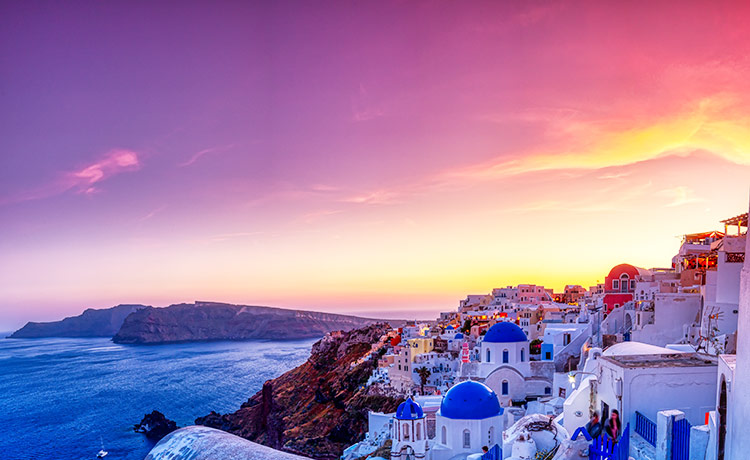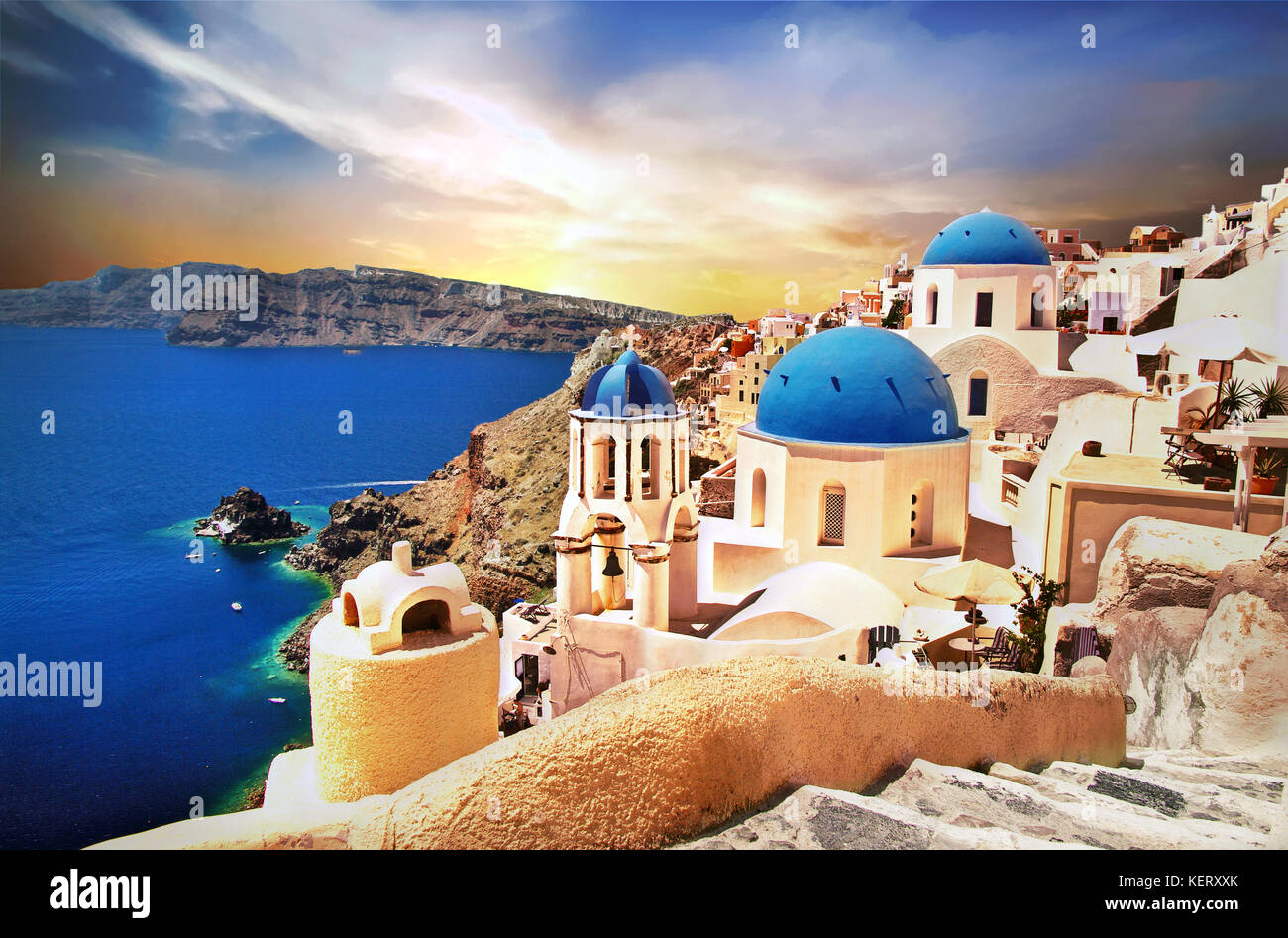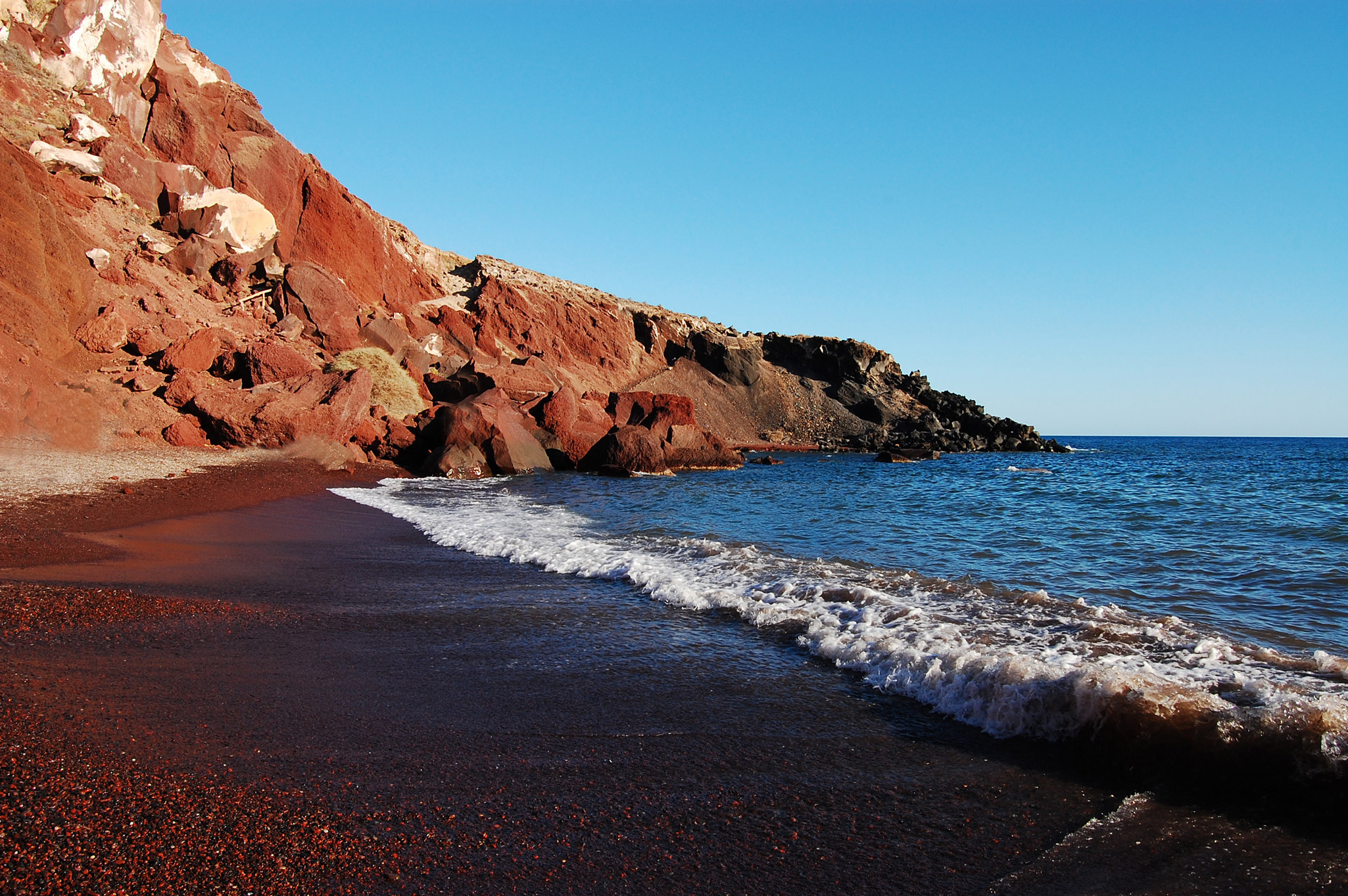
Intro
Nestled in the heart of the Aegean Sea, Santorini stands as one of the world’s most breathtaking destinations. With its iconic blue-domed churches perched on dramatic cliffs, mesmerizing sunsets, and volcanic landscapes, this Greek paradise offers an unforgettable experience for every traveler. This guide will take you through everything you need to know to plan your perfect Santorini getaway.
The Magic of Santorini’s Landscape
Santorini’s unique crescent shape is the result of one of the largest volcanic eruptions in recorded history, which occurred around 3,600 years ago. What remains today is a caldera (volcanic crater) partially submerged in the sea, creating the dramatic cliff formations that the island is famous for.
The island’s most recognizable features are its whitewashed buildings with vibrant blue domes, cascading down steep cliffs that plunge into the crystal-clear waters of the Aegean. This stark contrast of white against the deep blue sea creates a mesmerizing visual spectacle that has made Santorini one of the most photographed destinations in the world.

When to Visit: Finding the Perfect Time
Timing your visit to Santorini is crucial for an optimal experience. The island experiences a Mediterranean climate with warm, dry summers and mild winters.
Peak Season (July-August): While offering guaranteed sunshine and warm temperatures perfect for swimming, these months bring crowds and premium prices. The average temperature ranges from 24°C to 30°C (75°F to 86°F).
Shoulder Seasons (May-June, September-October): These periods are widely considered the best times to visit Santorini. You’ll enjoy pleasant temperatures between 18°C and 25°C (64°F to 77°F), fewer crowds, and more affordable accommodation. The sea is still warm enough for swimming, especially in early fall when the water retains summer heat.
Off-Season (November-April): Winter brings mild temperatures ranging from 10°C to 15°C (50°F to 59°F) and occasional rainfall. Many businesses close during this period, but you’ll experience a more authentic local atmosphere and significantly lower prices.
For the perfect balance of good weather, reasonable prices, and manageable crowds, aim for late May, June, or September. These months offer the ideal conditions for exploring all that Santorini has to offer. Greeka
Must-Visit Villages and Towns
Oia
Perched on the northern tip of the island, Oia (pronounced EE-ah) is Santorini’s crown jewel. Famous for its sunset views, blue-domed churches, and charming narrow streets, this picturesque village embodies the iconic Santorini postcard image.
The best time to explore Oia is early morning or late afternoon when cruise ship crowds are minimal. Don’t miss the famous sunset viewpoint near the Byzantine Castle ruins, but arrive early to secure a good spot—it gets extremely crowded.
Fira
As Santorini’s bustling capital, Fira offers a perfect blend of stunning caldera views, lively restaurants, and shopping opportunities. The town clings to the edge of the caldera, with a maze of stairs and alleyways leading to hidden gems at every turn.
The cable car from the Old Port provides spectacular views as you ascend the cliff face. Alternatively, the 587-step climb (or donkey ride) offers a more traditional, if strenuous, experience.
Imerovigli
Often referred to as the “balcony to the Aegean,” Imerovigli sits at the highest point of the caldera edge. This quieter village offers some of the island’s most breathtaking views and luxurious accommodations, with fewer crowds than Oia or Fira.
The famous Skaros Rock, a promontory formed by volcanic activity, is accessible via a hiking path and offers panoramic views that are worth the climb.
Unforgettable Experiences in Santorini
Hike from Fira to Oia
This iconic 10 km (6.2 mile) trail along the caldera’s edge is consistently rated as one of the best experiences in Santorini. The path winds through Fira, Firostefani, and Imerovigli before reaching Oia, offering uninterrupted views of the volcano and sea.
Allow 3-5 hours for the hike, wear comfortable shoes, and bring plenty of water. Starting early in the morning helps avoid both crowds and the midday heat. The diverse landscapes and changing perspectives make every step worthwhile.
Explore Ancient Akrotiri
Often called the “Minoan Pompeii,” this prehistoric settlement was preserved under volcanic ash from the eruption around 1600 BCE. The archaeological site features remarkably well-preserved multi-story buildings, advanced drainage systems, and beautiful frescoes that offer insights into the sophisticated civilization that once thrived here.
Guided tours are available and highly recommended to fully appreciate the historical significance of this ancient city.
Santorini Volcano and Hot Springs Tour
A boat tour to the volcano at the center of the caldera is a must-do activity. Most tours include a hike to the crater, where you can see steam vents and learn about the geological forces that shaped the island.
Many tours also stop at the hot springs near the small island of Palea Kameni, where you can swim in the mineral-rich, naturally warm waters. The iron content gives the water a rusty color, so avoid white swimwear!

Santorini’s Unique Beaches
Unlike the typical Greek islands with their golden sand beaches, Santorini offers distinct volcanic beaches with red, black, and white sand.
Red Beach
Located near Akrotiri, Red Beach features dramatic red volcanic cliffs contrasting with deep blue waters. The striking color comes from iron-rich volcanic rock. While small and often crowded, the unique scenery makes it worth visiting, even if just for photos. Note that there have been occasional rockslides, so check current safety advisories.
Perissa and Kamari (Black Sand Beaches)
These popular beaches on the eastern coast feature striking black volcanic sand. Both offer organized beach facilities with sunbeds, umbrellas, water sports, and beachfront tavernas. The sand can get extremely hot during summer days, so beach shoes are recommended.
White Beach
Accessible only by boat or by swimming from Red Beach, White Beach is named for its pale volcanic cliffs. This small, secluded cove offers crystal-clear waters and a peaceful atmosphere away from the crowds.
Culinary Delights of Santorini
Santorini’s volcanic soil creates ideal growing conditions for unique, intensely flavored produce that forms the foundation of local cuisine.
Must-Try Local Specialties
Fava: Unlike yellow split peas found elsewhere, Santorini’s fava is made from a local legume variety, resulting in a creamy, nutty puree typically topped with capers, onions, and olive oil.
Tomatokeftedes (Tomato Fritters): Made with the island’s famous small, sweet, intensely flavored tomatoes, these crispy fritters combine tomatoes with herbs, onions, and flour, then are lightly fried to perfection.

White Eggplant: Sweeter and less bitter than purple varieties, Santorini’s white eggplants are typically grilled or used in moussaka.
Chlorotyri: This soft, creamy goat cheese has a distinctive tangy flavor that pairs perfectly with the island’s cherry tomatoes.
Wine Tasting
Santorini has been producing wine for over 3,500 years, with vineyards that survived the phylloxera plague that devastated European vineyards in the 19th century. The island’s indigenous Assyrtiko grape produces crisp, mineral-rich white wines with high acidity.
Visit traditional wineries like Santo Wines, Domaine Sigalas, or Venetsanos Winery for tastings with caldera views. Don’t miss Vinsanto, a sweet dessert wine made from sun-dried grapes.
Where to Stay in Santorini
Choosing where to stay significantly impacts your Santorini experience, with options ranging from luxury cave houses on the caldera to more affordable accommodations inland.
Caldera View Accommodations
For the quintessential Santorini experience, stay in Oia, Imerovigli, or Fira with views of the caldera. These cliff-side hotels and villas offer private terraces, infinity pools, and unparalleled sunset views. However, this luxury comes with premium prices and often requires navigating many stairs.
Budget-Friendly Options
The eastern side of the island, including Kamari and Perissa, offers more affordable accommodations near black sand beaches. These areas provide excellent amenities and public transportation connections to the caldera towns.
Inland villages like Pyrgos and Megalochori offer authentic charm with lower prices than caldera locations while still providing easy access to the island’s attractions.
Practical Travel Tips
Getting Around
Bus: Santorini’s public bus system connects major towns and beaches with routes centering around Fira. Service is frequent during summer but limited in winter.
Car/ATV Rental: Renting a vehicle gives you freedom to explore at your own pace. ATVs are popular but exercise caution on the winding roads.
Taxi: Taxis are available but limited in number, so expect to wait during peak times.
Money-Saving Tips
- Book accommodations well in advance, especially for caldera views.
- Visit during shoulder seasons (May-June or September-October) for better rates.
- Consider hotels slightly away from prime sunset view locations for significant savings.
- Many caldera-view restaurants charge premium prices; inland tavernas offer authentic food at lower prices.
- Bring water and snacks when exploring to avoid purchasing at tourist prices.
Photography Tips
- For the classic blue dome church photos in Oia, visit early morning (before 8 AM) to avoid crowds.
- Sunset photos from Oia are stunning but extremely crowded; consider alternative viewpoints in Imerovigli or Santo Winery.
- The morning light creates beautiful shadows and textures on the whitewashed buildings.
- Use polarizing filters to enhance the contrast between the white buildings and blue sky.
Sustainability and Responsible Tourism
Santorini faces challenges with overtourism, especially during peak season. Consider these responsible practices during your visit:
- Visit during shoulder seasons to reduce pressure on infrastructure.
- Stay in locally owned accommodations rather than international chains.
- Respect private property when taking photographs, especially in Oia where many “Instagram spots” are actually private terraces.
- Conserve water, which is precious on the island and often transported from the mainland.
- Support local businesses and artisans instead of imported souvenirs.
- Avoid single-use plastics, as waste management is challenging on the island.
Conclusion: The Timeless Appeal of Santorini
Santorini captures the imagination like few other destinations, with its perfect balance of natural beauty, architectural wonder, rich history, and culinary delights. Whether you’re seeking romance, adventure, relaxation, or cultural experiences, this iconic Greek island delivers unforgettable memories.
The magic of watching the sunset paint the caldera in golden hues, savoring local wine while overlooking the Aegean, or wandering through narrow whitewashed passages creates moments that linger long after your tan fades. Santorini doesn’t just offer a vacation—it provides an experience that touches all the senses and remains etched in your heart forever.
When you visit, allow yourself time to absorb the island’s unique rhythm. Beyond the must-see attractions, it’s the small moments—an unexpected viewpoint, a conversation with a local shopkeeper, or the perfect bite of fava with a glass of Assyrtiko—that often become the most cherished memories of your Santorini adventure.
FAQs About Santorini
How many days should I spend in Santorini?
At least 3-4 days is recommended to experience the main attractions without rushing. If you want to explore at a leisurely pace and include beach time, 5-7 days would be ideal.
Is Santorini suitable for families with children?
Yes, though families should be aware of the many stairs and limited child-focused activities. Beaches like Kamari and Perissa are more family-friendly than the cliff-side towns.
Do I need to rent a car in Santorini?
Not necessarily. The public bus system is efficient during high season. However, a rental car or ATV offers more flexibility to explore at your own pace, especially for reaching less accessible beaches and villages.
Where is the best place to watch the sunset in Santorini?
Oia is famous for its sunset views, but it gets extremely crowded. Alternative spots include Imerovigli, Skaros Rock, Profitis Ilias Monastery, and Santo Wines in Pyrgos.
Is Santorini expensive?
Santorini is one of the more expensive Greek islands, especially for caldera-view accommodations and dining. However, by staying in inland villages, eating at local tavernas away from tourist centers, and visiting during shoulder seasons, you can experience Santorini on a more moderate budget.
What should I pack for Santorini?
Comfortable walking shoes, sun protection (hat, sunglasses, sunscreen), light breathable clothing, and a light jacket or sweater for evening sea breezes. If visiting in shoulder seasons, pack layers for cooler evenings.
Is the tap water in Santorini safe to drink?
While technically safe, most tap water in Santorini is desalinated and may have an unpleasant taste. Most visitors and even locals prefer bottled water, which is readily available.

Leave a Reply